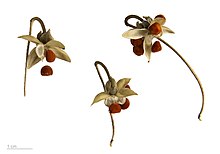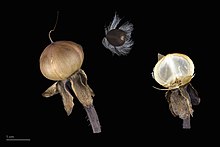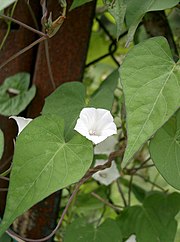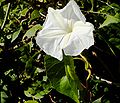Ipomoea
This article needs more primary sources. (November 2014) |  |
| Ipomoea | |
|---|---|

| |
Ipomoea batatas (sweet potato) flower
| |
| Scientific classification | |
| Kingdom: | Plantae |
| Clade: | Tracheophytes |
| Clade: | Angiosperms |
| Clade: | Eudicots |
| Clade: | Asterids |
| Order: | Solanales |
| Family: | Convolvulaceae |
| Tribe: | Ipomoeeae
|
| Genus: | Ipomoea L. 1753[1] |
| Species | |
|
More than 600, see list | |
| Synonyms[2] | |
|
List
| |





Ipomoea (
Their most widespread common name is morning glory, but some species in related genera bear that same common name and some Ipomoea species are known by different common names. Those formerly separated in Calonyction[6] (Greek καλός kalós "good" and νύξ, νυκτός núx, nuktós, "night") are called moonflowers.[5] The name Ipomoea is derived from the Greek ἴψ, ἰπός (íps, ipós), meaning "woodworm", and ὅμοιος (hómoios), meaning "resembling". It refers to their twining habit.[7]
Uses and ecology

Human uses of Ipomoea include:
- Most species have spectacular, colorful flowers, and are often grown as ornamentals, and a number of cultivars have been developed. Their deep flowers attract large Lepidoptera - especially the Sphingidae, such as the pink-spotted hawk moth (Agrius cingulata) - or even hummingbirds.
- The genus includes Apaches, or the Australian bush potato (I. costata). The peduncles or seed pods of Ipomoea muricata are consumed as a delicacy in the Indian state of Kerala.
- Peonidin, an anthocyanidin potentially useful as a food additive, is present in significant quantities in the flowers of the 'Heavenly Blue' morning glory cultivar.
- Ipomoea sepiaria, is part of the Dashapushpam (Ten sacred flowers) in Kerala and is known as "Thiruthali" in Malayalam.[8][9]
- Moon vine (Olmecs produced the balls used in the Mesoamerican ballgame.[10]
- The root called I. jalapa. The testicle-like dried tubers are carried as amulets and rubbed by the users to gain good luck in gambling or flirting. As Willie Dixon wrote, somewhat tongue-in-cheek, in his song "Rub My Root" (a Muddy Watersversion is titled "My John the Conquer Root"):
- My pistol may snap, my mojo is frail
- But I rub my root, my luck will never fail
- When I rub my root, my John the Conquer root
- Aww, you know there ain't nothin' she can do, Lord,
- I rub my John the Conquer root
As medicine and entheogen
Humans use Ipomoea spp. for their content of medical and
The leaves of I. batatas are eaten as a vegetable, and have been shown to slow oxygenation of LDLs, with some similar potential health benefits to green tea and grape polyphenols.[11]
Other species were and still are used as potent
Though most often noted as "recreational" drugs, the

Pests and diseases
Many
Pollination
The species of Ipomoea interfere with each other's pollination. Pollen from different species compete in each other's reproductive processes, imposing a
Gallery
-
Whitestar potato (I. lacunosa)
-
Ipomoea carnea in Brazil
-
Ipomoea marginata
-
Purple cultivar of Ipomoea indica
-
Ipomoea pes-caprae in China
-
Ipomoea sagittata in Florida
-
Ipomoea purpurea, Eastern Siberia
-
Ipomoea campanulata, India.
See also
References
- ^ "Genus: Ipomoea L." Germplasm Resources Information Network. United States Department of Agriculture. 2007-10-05. Archived from the original on 2010-05-28. Retrieved 2010-11-10.
- ^ "Ipomoea L." Plants of the World Online. Board of Trustees of the Royal Botanic Gardens, Kew. 2017. Retrieved 15 July 2020.
- ^ "Ipomoea". Lexico UK English Dictionary. Oxford University Press. Archived from the original on 2020-03-22.
- ^ Sunset Western Garden Book. 1995. pp. 606–07.
- ^ S2CID 44714712.
- S2CID 44714712.
- ISBN 978-0-8493-2332-4.
- OCLC 1197284682.
- ISSN 0974-3618.
- ^ Massachusetts Institute of Technology Summer Institute in Materials Science and Material Culture: Rubber Processing in Ancient Mesoamerica. Retrieved 2007-NOV-22.
- PMID 21562639.
- ISSN 1543-592X.
External links
- Dressler, S.; Schmidt, M. & Zizka, G. (2014). "Ipomoea". African plants – a Photo Guide. Frankfurt/Main: Forschungsinstitut Senckenberg.

















